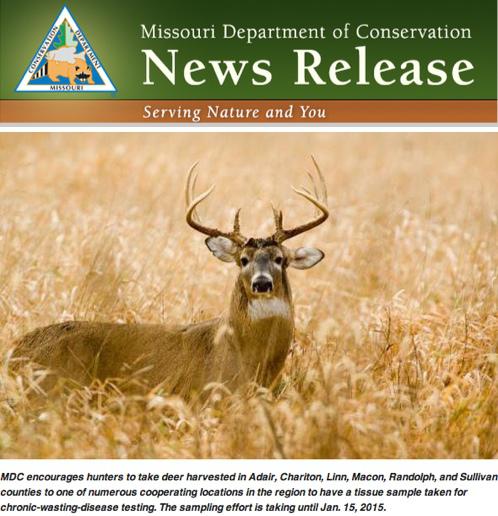Local News
MDC Reminds Deer Hunters to Properly Dispose of Carcasses
October 02nd 2014 by Dee Loflin

“Conservation makes Missouri a great place to hunt deer, and deer hunters are key to keeping it that way,” says MDC Deer Biologist Jason Sumners. “Because many hunters process their own deer, they are key players in slowing the spread of diseases such as CWD. One way that disease can spread is by the transportation and improper disposal of carcass parts.”
Deer can become infected with chronic wasting disease if they come into contact with other infected deer or with surface soil containing carcass parts from diseased deer. Deer carcass parts known to concentrate CWD include brain, spinal cord, eyes, spleen, and lymph nodes.
Chronic wasting disease was first found in Missouri in Macon and Linn counties several years ago. In response, MDC established a CWD Containment Zone covering Adair, Chariton, Linn, Macon, Randolph, and Sullivan counties. The disease remains limited to the local area.
“Hunters who harvest deer in these counties should not take whole deer carcasses out of the containment zone, or carcass parts that contain brain, spinal cord, eyes, spleen, or lymph nodes,” Sumners adds, along with the following information.
Proper Carcass Disposal
Avoid cutting through bones, spine, or brain when processing deer carcasses.
Remove meat in the field and leave the carcass behind. Bury it if possible.
If processing harvested deer in camp or at home, place carcass parts in trash bags and properly dispose of them through a trash service or landfill.
Take harvested deer to a licensed commercial processor to assure proper carcass disposal.
For taxidermy work, use a licensed taxidermist to assure proper carcass disposal.
Safe Parts to Transport
Meat that is cut and wrapped, or has been boned out,
Quarters or other portions of meat with no part of the spine or head attached,
Hides or capes from which all excess tissue has been removed,
Antlers, including antlers attached to skull plates or skulls cleaned of all muscle and brain tissue, and
Finished taxidermy products.
The Wildlife Code of Missouri requires hunters who harvest deer, elk, or moose out of state and bring the animal with the spinal column or head attached into Missouri to call toll free, 877-853-5665, and report the animal’s entry within 24 hours. They also must take the carcass to a licensed meat processor or taxidermist within 72 hours of entry. This is designed to prevent introducing CWD into new areas of Missouri from other states. Hunters transporting deer through Missouri en route to other states do not need to call the number.
Donate Tissue Samples
Sumners also encourages hunters who harvest deer within the CWD Containment Zone of Adair, Chariton, Linn, Macon, Randolph, and Sullivan counties to donate tissue samples from their deer to the Conservation Department for its CWD monitoring program. Numerous deer-processing facilities and taxidermists in the area are participating in the effort.
Details about these measures are listed in the 2014 Fall Deer & Turkey Hunting Regulations and Information booklet, which is available at MDC offices and nature centers, where hunting permits are sold, and online at mdc.mo.gov/sites/default/files/resources/2010/03/ftd2014.pdf.
Last Updated on October 02nd 2014 by Dee Loflin
https://showmetimes.com/Blogpost/usqg/MDC-Reminds-Deer-Hunters-to-Properly-Dispose-of-Carcasses

